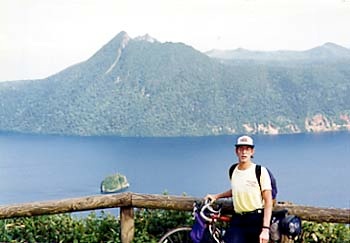

































Mountain folk would know immediately what this is... at least in winter. Hokkaido has some of Japan's finest ski slopes in winter, but this is what they look like in summer. In some places (like Nozawa Onsen) people actually grow vegetables directly under the ski lifts in the warmer months...
Not far from Akan-ko is yet another lake, and perhaps the most famous of all: Masshu-ko, usually known by the phrase "Kiri no Masshu-ko" because it's normally shrouded in fog (kiri). If you want to actually see the lake (it was completely fogged in during my first visit years ago), you should come in August, which has many days like this - a rare view of "kiri-no-nai" (clear-as-a-bell) Masshu-ko. The lake once had some of the purest water in Japan, but now, alas, it is no longer pure due to all the "carp" in the water. That’s not a typo: a few years ago some genius had the bright idea of releasing koi (Japanese carp) into the lake, not realizing that they would soon make the water somewhat less than pure.